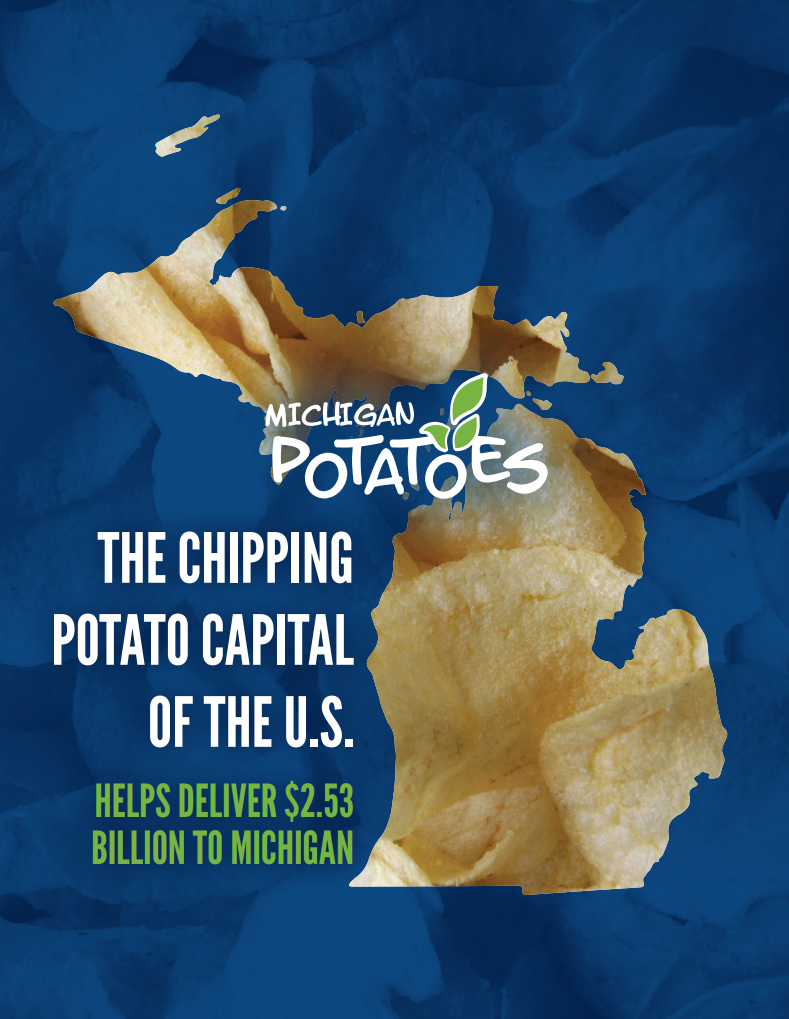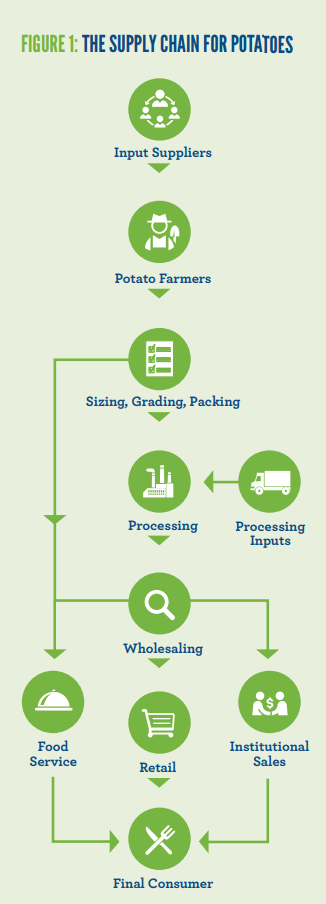Information on Study, Researchers, MSU, etc.

Rotating Banner

The Michigan Supply Chain of Potatoes
Table 2 shows the production of potatoes in Michigan from 2009 to 2022. The data shows a long-term trend of growth in Michigan potato production, especially since 2014. Seed use has increased from about 1.1 million cwt. to about 1.4 million cwt. in 2019; it then declined to about 1.1 million cwt. in 2022. Farm use has also increased from about 215,000 cwt. to about 350,000 cwt. in the late 2010s. It has since declined to 260,000 cwt. in 2022. Farm use includes potatoes used by the farmer and potatoes used as animal feed. These potatoes generally do not meet the quality standards to be sold to processors or retailers. Due to improved management practices and breeding techniques the number of potatoes lost to shrinkage and loss has been cut by more than half since 2009 (USDA, NASS). Despite such gains in potato production, Michigan potatoes face significant pest and disease challenges that may disrupt any given year’s production. Table 2 further shows that farm use makes up less than two percent of total production. Depending on the year, seven to eight percent of the potato crop is used for seed.
Michigan is an important potato producing market, and Montcalm County is the largest potato production county in Michigan. The state is the nation’s leading producer of potatoes for potato chip processing and a primary source of potatoes for other uses (Cultivate Michigan, 2016). According to the most recent agricultural Census, 761 Michigan farms produced potatoes in 2017, down from 934 in 2012. While only 107 growers indicated growing potatoes for processing, they accounted for 80 percent of the total acres under potato production (USDA: NASS, 2019). Accordingly, the larger farms, by acres, tend to produce processed potatoes. Potatoes are Michigan’s second leading produce commodity. Nearly 1.88 billion pounds of potatoes are harvested annually in Michigan, generating $246 million in sales (USDA, NASS). White and Russet potatoes are the two dominant types of potatoes grown in Michigan. About 85 percent of potato production in Michigan are white potatoes; Russet potatoes account for about 13 percent of production and an additional one to two percent of production is comprised of red and yellow potatoes (USDA, NASS). Most of the potatoes grown in Michigan are produced under contract (Source Trace Systems 2020), as the general practice for process potato farming in the U.S. is to sign forward contracts for future delivery.
PepsiCo and Campbell Soup Company, through their Frito-Lay and Snyder-Lance divisions, are the largest producers of chips. Though the snack food segment exhibits slow growth, there is some growth in craft or specialty chip production. There is also product innovation in the chip sector focusing on lower sodium varieties, baked chips, and chips with a lower oil content designed to improve the healthfulness of chips (Diment 2021). Processed potato production entails vast inputs from producers in other agricultural production sectors, as well as from other manufacturing sectors – particularly for packaging and processing. Processors use inputs to produce finished products. Examples of these are packaging, utilities, salt, breading, spices, other agri-food inputs, cooking oil, and energy. The types of inputs brought into the processed potato production process depend on the type of product processed. To be sure, potatoes are also inputs to other processed and packaged food products, where potatoes are secondary components. Potatoes and processed potato products are then handled by wholesalers. In some cases, large firms manage their own warehouses, which means they do not need to use wholesale services but carry out some of the activities that wholesalers do internally. The potatoes and potato products are then handled by retailers, foodservice firms, and institutions such as schools and hospitals. The products are then bought or consumed by the final consumer. A stylized depiction of the complete supply chain from farm input suppliers to consumers is shown in Figure 1. Potato quality is important for both the fresh and processed potato markets. Since many potatoes are marketed through contracts, grading and sizing are important activities. Some potatoes destined for the fresh market go straight to potato wholesalers, and then go to either the retail market or food service or institutional sales. Given the popularity of potatoes and their versatility, the supply chain for potatoes is more complex compared to many other agricultural commodities.
Jobs





